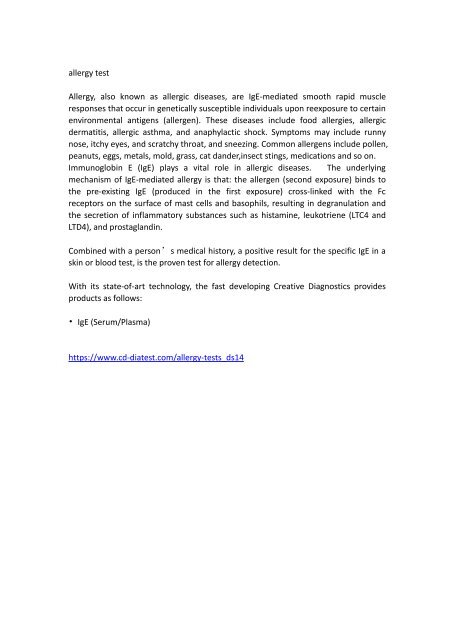allergy test
Immunoglobin E (IgE) plays a vital role in allergic diseases. The underlying mechanism of IgE-mediated allergy is that: the allergen (second exposure) binds to the pre-existing IgE (produced in the first exposure) cross-linked with the Fc receptors on the surface of mast cells and basophils, resulting in degranulation and the secretion of inflammatory substances such as histamine, leukotriene (LTC4 and LTD4), and prostaglandin.
Immunoglobin E (IgE) plays a vital role in allergic diseases. The underlying mechanism of IgE-mediated allergy is that: the allergen (second exposure) binds to the pre-existing IgE (produced in the first exposure) cross-linked with the Fc receptors on the surface of mast cells and basophils, resulting in degranulation and the secretion of inflammatory substances such as histamine, leukotriene (LTC4 and LTD4), and prostaglandin.
You also want an ePaper? Increase the reach of your titles
YUMPU automatically turns print PDFs into web optimized ePapers that Google loves.
<strong>allergy</strong> <strong>test</strong><br />
Allergy, also known as allergic diseases, are IgE-mediated smooth rapid muscle<br />
responses that occur in genetically susceptible individuals upon reexposure to certain<br />
environmental antigens (allergen). These diseases include food allergies, allergic<br />
dermatitis, allergic asthma, and anaphylactic shock. Symptoms may include runny<br />
nose, itchy eyes, and scratchy throat, and sneezing. Common allergens include pollen,<br />
peanuts, eggs, metals, mold, grass, cat dander,insect stings, medications and so on.<br />
Immunoglobin E (IgE) plays a vital role in allergic diseases. The underlying<br />
mechanism of IgE-mediated <strong>allergy</strong> is that: the allergen (second exposure) binds to<br />
the pre-existing IgE (produced in the first exposure) cross-linked with the Fc<br />
receptors on the surface of mast cells and basophils, resulting in degranulation and<br />
the secretion of inflammatory substances such as histamine, leukotriene (LTC4 and<br />
LTD4), and prostaglandin.<br />
Combined with a person’s medical history, a positive result for the specific IgE in a<br />
skin or blood <strong>test</strong>, is the proven <strong>test</strong> for <strong>allergy</strong> detection.<br />
With its state-of-art technology, the fast developing Creative Diagnostics provides<br />
products as follows:<br />
• IgE (Serum/Plasma)<br />
https://www.cd-dia<strong>test</strong>.com/<strong>allergy</strong>-<strong>test</strong>s_ds14














